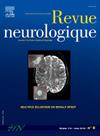Mechanisms of immune tolerance breakdown in paraneoplastic neurological syndromes
IF 2.8
4区 医学
Q2 CLINICAL NEUROLOGY
引用次数: 0
Abstract
Paraneoplastic neurological syndromes (PNS) are rare autoimmune disorders triggered by the presence of a cancer. The autoimmunity is herein directed against proteins expressed both in the tumor and in the nervous system, namely the onconeural antigens, against which are directed specific autoantibodies, each of them characterizing a neurological syndrome. The mechanisms of the immune tolerance breakdown in PNS leading to the production of specific autoantibodies directed against the nervous system and leading to the immune attack begins to be explained. Each syndrome is associated with a specific histo-molecular subtype of tumor suggesting a link between the PNS genesis and oncogenesis. The expression of the onconeural antigen by these tumors is insufficient to explain the immune tolerance breakdown. In some PNS tumors, alterations of the antigen have been identified: mutations, gene copy number variation and overexpression of transcript and protein. But in others PNS, no such molecular alterations of the onconeural antigens have been demonstrated. In these cases, other mechanisms of neoantigen generation that may be involved remain to be deciphered. Cancer outcomes of PNS tumors are also characterized by the high frequency of lymph node metastasis at diagnosis. At the primary tumor site, the antitumor immune reaction seems to be particularly intense and characterized by a prominence of B-cell and Ig-secreting plasma cells that may generate the autoantibody secretion. The immune control mechanisms leading to such organization of the immune attack are not known to date. Renewed research efforts are thus needed to better understand the mechanism of immune tolerance breakdown in each PNS and determine potential targets to meet the therapeutic challenges posed by these rare disorders.
副肿瘤性神经综合征的免疫耐受破坏机制。
副肿瘤性神经综合征(PNS)是由癌症引发的罕见自身免疫性疾病。自身免疫针对的是肿瘤和神经系统中都表达的蛋白质,即肿瘤抗原,针对这些抗原产生特异性自身抗体,每种抗体都是一种神经综合征的特征。我们开始解释 PNS 免疫耐受破坏导致产生针对神经系统的特异性自身抗体并引发免疫攻击的机制。每种综合征都与特定的组织分子亚型肿瘤有关,这表明 PNS 的发生与肿瘤发生之间存在联系。这些肿瘤表达的肿瘤抗原不足以解释免疫耐受的崩溃。在一些 PNS 肿瘤中,已发现抗原发生了改变:突变、基因拷贝数变异以及转录本和蛋白质的过度表达。但在其他一些 PNS 中,则未发现肿瘤抗原有此类分子改变。在这些病例中,可能涉及新抗原生成的其他机制仍有待破译。PNS 肿瘤的癌症结局还以诊断时淋巴结转移的高频率为特征。在原发肿瘤部位,抗肿瘤免疫反应似乎特别强烈,其特点是 B 细胞和分泌 Ig 的浆细胞突出,可能产生自身抗体分泌。迄今为止,导致这种免疫攻击组织的免疫控制机制尚不清楚。因此,需要重新开展研究工作,以更好地了解每种 PNS 免疫耐受破坏的机制,并确定潜在的靶点,以应对这些罕见疾病带来的治疗挑战。
本文章由计算机程序翻译,如有差异,请以英文原文为准。
求助全文
约1分钟内获得全文
求助全文
来源期刊

Revue neurologique
医学-临床神经学
CiteScore
4.80
自引率
0.00%
发文量
598
审稿时长
55 days
期刊介绍:
The first issue of the Revue Neurologique, featuring an original article by Jean-Martin Charcot, was published on February 28th, 1893. Six years later, the French Society of Neurology (SFN) adopted this journal as its official publication in the year of its foundation, 1899.
The Revue Neurologique was published throughout the 20th century without interruption and is indexed in all international databases (including Current Contents, Pubmed, Scopus). Ten annual issues provide original peer-reviewed clinical and research articles, and review articles giving up-to-date insights in all areas of neurology. The Revue Neurologique also publishes guidelines and recommendations.
The Revue Neurologique publishes original articles, brief reports, general reviews, editorials, and letters to the editor as well as correspondence concerning articles previously published in the journal in the correspondence column.
 求助内容:
求助内容: 应助结果提醒方式:
应助结果提醒方式:


